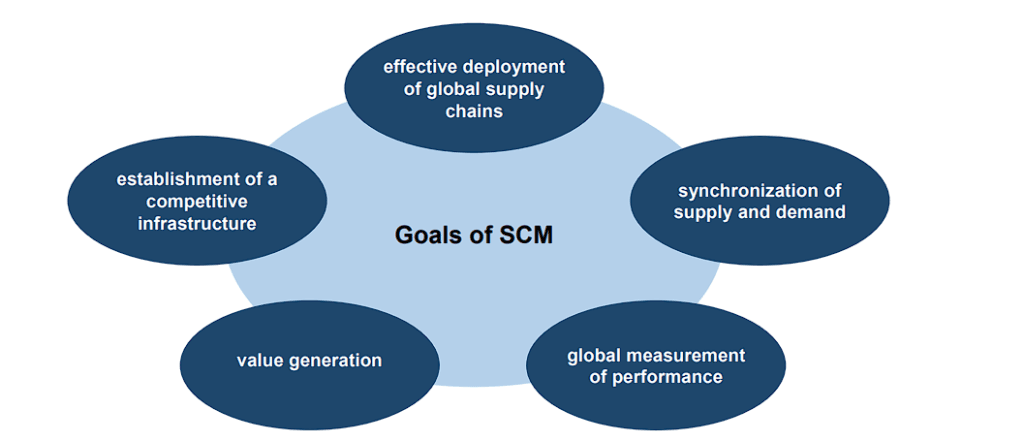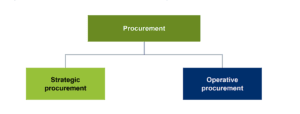Activities like sourcing and procurement, conversion, and all logistics are managed and planned under supply chain management. Coordination and collaboration with channel partners also comprises in supply chain management. It unites supply and demand management within the company.
Goals of Supply Chain Management

- Establishment of a competitive infrastructure.
- Effective development of global supply chains.
- Synchronisation of supply and demand.
- Global measurement of performance.
- Value generation.
The Supply Chain Operations Reference
SCOR model is a type of process reference model. It is a standard supply chain management diagnostic tool. The SCOR model was created to describe the commercial activities related to all stages of meeting customer demand. It can serve as a guide for uniformising supply chains within and between businesses. SCOR is a coherent reference system that combines elements of business process, Like optimisation, comparison of performance indicators, and business practices. The SCOR model uses process elements in order to describe the supply chain. It includes the following elements :
- Plan
- Procurement
- Production
- Delivery
- Redelivery
Three hierarchical process levels characterise the SCOR model.
|
Level I |
Level II |
Level III |
|
Tally the number of supply chains and the description of their performance measurement, namely the scope and content. |
Define the sequence of planning and implementation processes for material flows. |
Establish business processes, orders, permissions, re-deliveries and marketing forecasts. |
SCOR model is a supply chain improvement framework provided by the SSC. It was developed by the Supply Chain Council. This Council is a non-profit consortium founded in 1996. Also, the council has members from all industries.
Characteristics of SCOR
- It is a cross-industry standard process reference model.
- It is widely accepted for evaluating and comparing supply chain activities and performance.
- It also enables improvements to supply chain practices within and between all parties.
- It also provides a standard language to communicate supply chain management practices.
The SCOR Model Contains
I. Business process modelling.
II. Benchmarking performance.
III. Best practices analysis.
Business Process Modelling
|
|
Level |
l Description |
Example |
|
Level 1 |
configuration of the supply chain to core management processes |
plan, source, make, deliver, return |
|
|
Level 2 |
Further delineation of the core management processes into process categories |
Make: make-to-stock make-to-order engineer-to-order |
|
|
Level 3 |
Description of the process elements performed to execute the process categories |
make-to-order: schedule production, issue product, produce and test package, etc. |
|
|
Industry-specific
|
Level 4 |
Description of the industry-specific activities to perform the process elements |
Issue product in the electronics industry: print pick list, pick items (bin), deliver bin to production cell, etc |
Benchmarking Performance
- It is a hierarchical approach to measure the performance of the supply chain processes.
- It identifies the main performance gaps and positions with respect to competitors.
- It has metrics that include more than 150 KPIS.
- It has performance targets that include supply chain reliability, responsiveness, flexibility and costs.
Best Practice Analysis
It identifies the required activities to close the performance gaps in supply chain optimisation, risk management and environmentally responsible supply chain management. Best practices have to be current, structured, proven, repeatable, have an ambiguous method and have a positive impact on results. SCOR includes more than 400 best practices, e.g. management practices.
SIEMENS use the SCOR Model
Siemens uses the SCOR to enhance the effectiveness of its processes and supply chain. 250+ internal change agents split into teams to begin reviewing strategies, opportunities, and challenges. For instance, Siemens uses SCOR to simplify the Make-to-Order procedures for its “Social Medical Solutions” business, whose computed tomography (CT) equipment is produced in China and Germany. A lot of “make-to-order” tasks occur in this particularly challenging business, including global management, complex material management, customisation and production, technical support, global dispatch and logistics, and installation at the client’s location.
Procurement and Purchasing in the Supply Chain
Procurement and purchasing management is a process that includes information about provision, planning, and control, which aims at providing the required purchase of an enterprise’s objects in an appropriate form of transaction and transfer processes.
Types of Procurement

Procurement is classified into strategic procurement and operational procurement. The operative procurement deals with short-term decisions in the daily business of operation.
Strategic procurement involves long-term business decisions.
The strategic objectives build the framework for operational business.
Strategic procurement and Operational procurement
| Strategic Procurement | Operative procurement |
| long-term decisions optimising the price/performance ratio Procurement market research qualified bid comparison contract negotiations global, single, modular sourcing of A-parts Diversification of the supply risk supplier evaluation framework contracts assurance of material quality Procurement process optimisation shortening of lead times reduction of inventory and procurement costs risk management |
short-term decisions pure order activity daily business planning and forecasting, requests, inquiries, orders B- and C-part management level of safety stock ensuring material availability monitoring of deadlines, quantity and quality specifications electronic procurement risk management assurance of material quality Procurement process optimisation shortening of lead times reduction of inventory and procurement costs risk management |
Supply Chain Management Salary
Supply chain management salary can vary depending on job role, level of experience, industry, and location. Numerous professions fall under Supply chain management. These professions are listed below :
- Procurement specialists
- Logistics coordinators
- Supply chain analysts
- Operations managers
- Supply chain directors
Let’s discuss the salary range in the United States based on experience levels:
- Entry-level or less than 2 years of experience ranges from $40,000 to $60,000 per year
- Mid-level or 2 to 5 years of experience ranges from $60,000 to $90,000 per year
- Experienced or 5 to 10 years of experience ranges from $90,000 to $120,000 per year
- Senior or more than 10 years of experience ranges from $120,000 and above per year
It is important to clarify that these figures can vary based on individual circumstances and company. Because the job market and economic conditions change over time.
FAQ
Question1. Which of the following best describes supply chain management
a. Supply chain management is supply chain-driven.
b. Supply chain management focuses on pulling products into the marketplace.
c. Outsourcing is not used with supply chain management.
d. Supply chain management focuses on pushing products into the marketplace.
Answer. d
Question2. What is strategic sourcing in supply chain management, quizlet
Answer. Organisations use strategic sourcing to buy goods and services from external suppliers. It views the supply chain holistically and long-term. Strategic sourcing reduces costs, improves quality, efficiency, and supplier relationships. Strategic sourcing involves:
- Supplier Evaluation: Assessing and selecting suppliers based on capabilities, reliability, financial stability, and performance history.
- Negotiation: Negotiating pricing, payment, and service terms with suppliers.
- Supplier Relationship Management: Building strong partnerships with key suppliers for collaboration, innovation, and growth.
- Risk management: Identifying and mitigating supply chain risks like supply disruptions, geopolitical issues, and regulatory changes.
- Total Cost of Ownership (TCO) Analysis: Assessing the total cost of buying and using a product or service, including maintenance, support, and disposal.
- Technology: Optimising procurement, data analysis, and decision-making with advanced tools and software.
- Continuous Improvement: Adjusting sourcing strategies to market changes, technology advances, and organisational needs.
Organisations can improve performance, efficiency, cost, and supply chain risk by strategically managing the sourcing process.
